BASE HEADER
Issue and Options 2023
1. Introduction
1.1 Purpose of the Consultation
Stratford-on-Avon District and Warwick District Councils are seeking the views of residents, businesses, developers, infrastructure providers, community groups and all other stakeholders on how we should plan for the future of South Warwickshire to 2050. This new local plan is about where and how, new jobs, infrastructure and housing are all delivered in the context of place-shaping and addressing climate change.
We are still the early stages of the process (stage 2 of 8) and further public consultation will follow. This consultation sets out a number of ideas and asks a series of questions. We want your views on the ISSUES we raise and the OPTIONS we propose as possible solutions.
1.2 South Warwickshire Today
Located to the south of the West Midland's conurbation, South Warwickshire covers 488 square miles of predominately open countryside and is made up of Stratford-on-Avon and Warwick District Council Areas. With good motorway and rail connections between London and Birmingham, South Warwickshire is the gateway to the West Midlands.
South Warwickshire has a varying landscape and includes parts of 5 national landscape character areas, of which the Cotswold Area of Outstanding Natural Beauty is one, with 8% of the total area of South Warwickshire falling into this specific national landscape designation. Nearly a third of South Warwickshire is part of the West Midlands Green Belt, which is designed to prevent the unplanned expansion of urban areas.
Figure 1 – South Warwickshire Facts and Figures
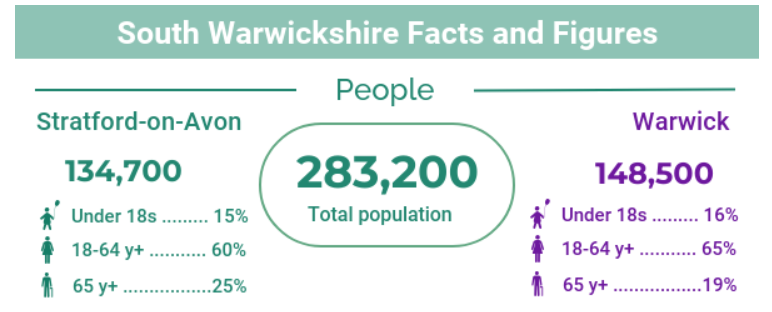


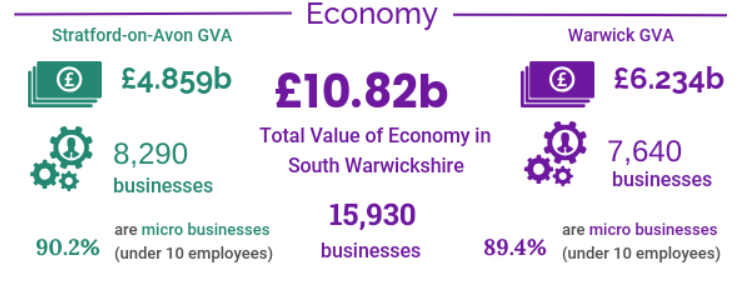
Figure 2 – South Warwickshire Key Diagram (as existing)
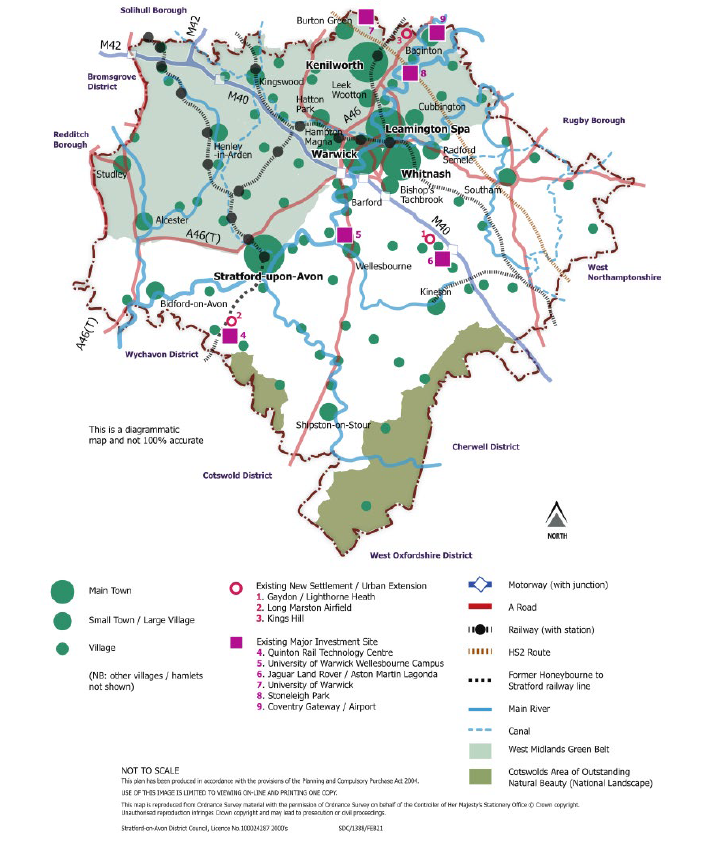
1.3 What is the South Warwickshire Local Plan (SWLP)
A Local Plan is a legal document that councils are required to prepare that sets out the future land use and planning policies for an area over a set period of time. It will contain the planning policies that the two councils will use to determine planning applications. The South Warwickshire Local Plan will be the Local Plan of both Stratford-on-Avon District Council and Warwick District Council areas and will run up to 2050. It will also set out how we will deliver new jobs, new infrastructure and new homes to grow South Warwickshire's economy and help deliver on both Council's commitment to address the climate change emergency.
Once Part 1 is fully adopted, it will replace the existing strategic policies of the Stratford-on-Avon District Council Core Strategy and Warwick District Councils Local Plan. Local Plans are required to be in line with the National Planning Policy Framework and should seek to achieve sustainable development taking into account, economic, social and environmental factors. In addition to the NPPF, the South Warwickshire Local Plan will also need to take account of the Environment Act, the sustainable development goals and the emerging legislation contained within in the Levelling up and Regeneration Bill.
The South Warwickshire Local Plan will also need to take account of other plans and strategies including those of the West Midlands Combined Authority (WMCA) and Warwickshire County Council, with particular attention being made to the Local Transport Plan which sets out the transport needs, challenges and priorities and objectives for the county, as well as the Minerals and Waste Core Strategy which sets out the strategy and policies for guiding minerals and waste development in the county. Consideration will also need to be given to the plans and proposals of various infrastructure providers to ensure that new development is supported by the necessary infrastructure.
Neighbourhood Plans, which are prepared by Parish Councils or Neighbourhood forums, are required to be in line with the strategic context of the Local Plan, it may therefore be that communities will wish to review their neighbourhood plans in due course. Importantly, however, much of the detailed content of neighbourhood plans won't be affected by Part 1 of the new South Warwickshire Local Plan and policies set out in existing neighbourhood plans will continue to be relevant.
1.4 What is the SWLP Part 1?
Rather than have a single comprehensive plan it is envisaged that the plan will be broken down into separate parts as shown in Figure 3.
Part 1 of the Plan will establish a robust and flexible framework which will set out where and how much development should take place across South Warwickshire. This will include core principles and strategic policies that provide a context in which more detailed policies will follow. There is an exception to this in relation to the climate change policies. Due to the climate change emergency, it is expected that there will be a full suite of policies on climate change in part 1. As well as strategic policies, part 1 of the plan will also look to include strategic sites, which are sites that are critical to the delivery of the plan.
Existing policies which are not included in part 1 of the plan could be saved and subsequently incorporated into Part 2 of the plan and/or other policy documents as appropriate. Part 2 of the plan will contain more detailed policies or policies that are much more specific to a local area. For example, a particular issue in Royal Leamington Spa, but not necessarily South Warwickshire, is the need to manage purpose-built student accommodation.
Figure 3: Different Parts of the SWLP
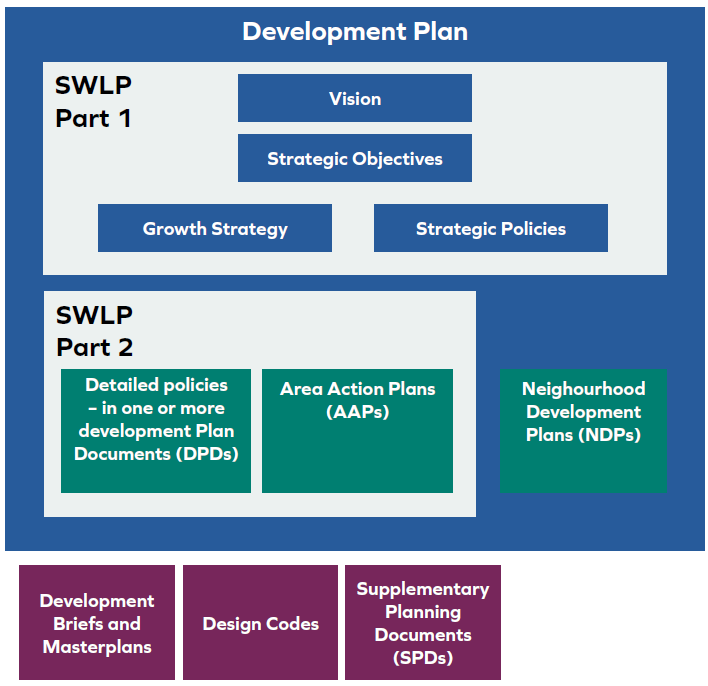
Further detail around the proposed contents of the Part 1 plan can be found in Chapter 12.
The plan period is the length of time that the policies in the Local Plan will remain valid for. This Local Plan for South Warwickshire will run up to 2050 which will allow for a flexible, robust, and long-lasting framework for development. By taking a long-term perspective, we can better take account of the investment plans of infrastructure providers to better ensure that new jobs and homes are supported by the necessary infrastructure.
1.5 How is the SWLP being prepared?
In preparing the SWLP we need to base our proposals on expert technical evidence covering a range of planning topics. Our interpretation of this evidence is influenced by the feedback we receive from stakeholders, including the views of residents and businesses. Everything we do is also within the context set by national planning policy and guidance.
Figure 4 – Preparation of the SWLP
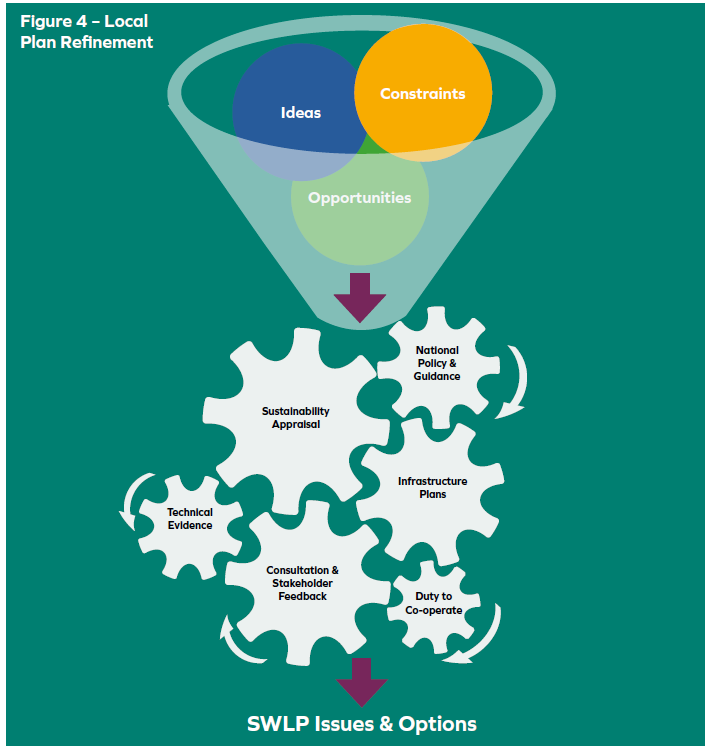
Ultimately, the SWLP must contribute to the achievement of sustainable development, and this means balancing the need for more jobs and homes against the impact on the built and natural environment. To help us understand and mitigate those impacts we prepare a Sustainability Appraisal that also accompanies this consultation document.
1.6 What have we done so far?
Scoping and Call for Sites Consultation
Preparing the SWLP is not a single event and there are numerous stages of consultation (see Figure 5 below). The first consultation was the Scoping and Call for Sites consultation which took place in 2021. There were two aspects to that consultation; firstly to explore what the broad content of the SWLP should be and secondly to seek suggestions for sites for development through the call for sites request.
We have analysed the responses to the consultation and they are available to view in the accompanying consultation statement. More importantly, the feedback has been used to inform the content of this Issues and Options consultation.
Through the call for sites, 558 sites were put forward for a range of uses, and each one has been processed and mapped onto the interactive call for sites map. Although the sites have been published no analysis of the sites has yet taken place, and therefore publication is by no means an endorsement by either Council that the site is either suitable for development or will be included within the local plan itself.
A further call for sites is running alongside the Issues and Options consultation, and further details on this can be seen in Section 2.4.
Stakeholder Engagement
As part of the preparation for the Issues and Options Consultation document we have engaged with various stakeholders, including Parish Councils and key infrastructure organisations, and have conducted interactive stakeholder sessions. Full details of the stakeholder engagement can be found within the topic paper "Evolving the Spatial Growth Options – the story so far".
Technical Evidence
Officers on the SWLP team have also commissioned a number of external consultants to conduct numerous technical assessments. The Technical Evidence that has been obtained following the Scoping and Call for Sites Consultation, and that will be published alongside the Issues and Options consultation is as follows:
- Bus Accessibility Mapping
- Estimation of emissions for proposed growth options and new settlements
- Climate Change Baseline Report
- Equalities Impact Assessment (EIA)
- Habitats Regulations Assessment (HRA)
- Heritage Assessments
- Housing & Economic Development Needs Assessment (HEDNA) –Coventry and Warwickshire
- Settlement Design Analysis
- Sustainability Appraisal (SA)
- Strategic Flood Risk Assessment (SFRA) – Part 1
- Urban Capacity Study
Further details on the technical evidence can be found on the Technical Evidence webpage on the South Warwickshire Local Plan Website. These assessments have all been published so that respondents and interested parties can view the evidence and use it to inform their responses.
1.7 Structure of the Issues and Options Consultation
The issues and options consultation follows on from the Scoping and Call for Sites consultation as mentioned above. It sets out some of the key issues raised at earlier stages of the plan making process and presents a number of options to overcoming these.
This consultation document is split into twelve chapters and at the beginning of chapter 3 onwards there is a short explanation as to the issues covered in that chapter.
Throughout the document we have included boxes containing brief summaries of responses to various issues from the Scoping and Call for Sites consultation. These boxes are intended to help show how your responses have been considered for the Issues and Options. An example box is shown below.
What you said:
- Text here
We have also cross referenced back to the two existing local plans so you can see how the new policies proposed in the SWLP may relate to the existing planning policies of the two Councils.
Current Policy Approach:
- Text here
Throughout the document there are a number of 'options' which are proposed to help overcome various issues. The Issues and Options Consultation document seeks to determine which of these options residents and stakeholders consider most favourable. In addition to options presented for various policy issues, the document also presents a number of strategic spatial 'growth options'. These spatial growth options will help determine where development takes place across the local plan area, and the Issues and Options consultation document seeks the views of residents and stakeholders, as to which spatial growth option they find most suitable for South Warwickshire. As part of the spatial growth options work, there are also questions regarding New Settlements and any role they may play in helping to deliver the necessary growth required over the plan period. There are also a number of questions which officers are seeking resident and stakeholder views on.
A new 'Call for Sites' exercise is running simultaneously to this consultation. This provides an opportunity to submit land/sites to us which will be assessed, and as appropriate considered in the plan-making process. This is further to a similar exercise undertaken in 2021 (see Section 1.6 above 'what we have done so far').
We are seeking sites for a range of uses to support the objectives of the emerging SWLP. These should not however duplicate previous submissions which are already recorded (see interactive map). We are especially keen to attract sites which would support one or more of the spatial growth options within this document, and sites which could support the transition to Net Zero, such as sites which could be used for renewable energy generation.
The interactive form and further information on the Call for Sites is available on our Call for Sites webpage.
The Issues and Options is the second stage in the process of preparing the SWLP and we still have a long way to go. As shown in Figure 5. Preparing the local plan is a process of refinement as we narrow down our ideas into our preferred option and final plan.
Figure 5 - Timetable for the SWLP
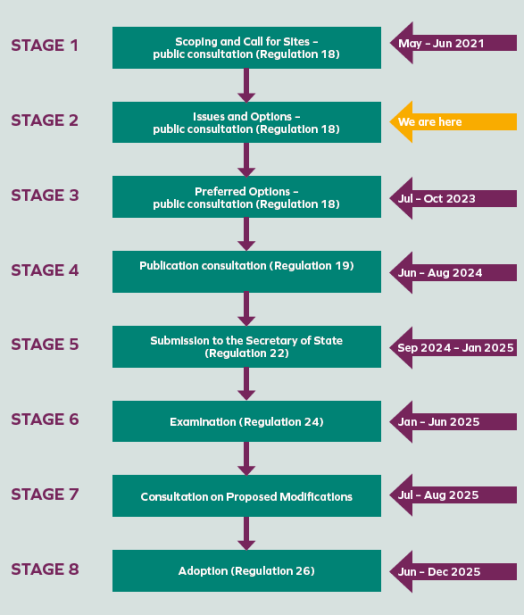
1.8 Next stages after this consultation
Once the Issues and Options Consultation has closed, officers will analyse the responses and the gathered technical evidence and use this information to inform the next iteration of the plan, the Preferred Options. The Preferred Options document will present a refined approach to the issues raised within this document, and the spatial growth strategy, based on the feedback received and analysis of the evidence gathered. It will show more clearly the direction of travel for development within South Warwickshire.
In addition to analysing the existing evidence base and the responses received, officers will also commission and undertake additional Technical Assessments/Studies to inform the plan as it progresses. This may include:
- Air Quality Assessment
- Biodiversity & Green Infrastructure Assessment
- Climate Change Impact Assessment
- Equalities Impact Assessment (EIA)
- Green Belt Study
- Habitats Regulations Assessment (HRA)
- Health Impact Assessment (HIA)
- Heritage Assessment
- Infrastructure Delivery Plan
- Landscape Character Assessment
- Playing Pitch Strategy
- Site Delivery & Viability Studies
- Strategic Environmental Assessment / Sustainability Appraisal (SA/SEA)
- Housing and Economic Land Availability Assessment (HELAA)
- Strategic Flood Risk Assessment (SFRA) Part 2
- Town Centre Studies
- Transport Assessment
- Water Cycle Study
Once the Preferred Options document has been produced, taking into consideration the responses from the Issues and Options and the findings from the technical assessments, it will go out to consultation. Following this, the Publication Draft of the South Warwickshire Local Plan will be created.